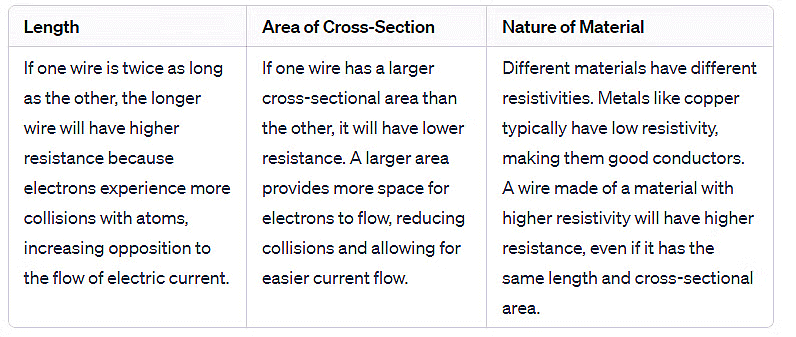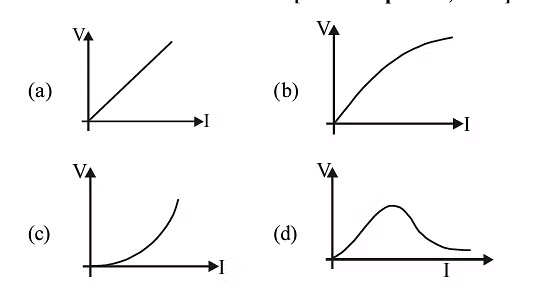Resistance, Resistivity and Ohm's Law | Physics for JEE Main & Advanced PDF Download
Have you ever wondered why your elders always tell you to never touch electrical switches or appliances with wet hands? You must also have seen or heard about unfortunate events caused due to electrocution. How does electricity become so dangerous that it causes fires, human body disorders, or even death?
In this document let us unfold the answers to the above questions by understanding the concepts of resistance, resistivity, and finally the most fundamental law of electricity, that is, Ohm's law.
Resistance
- When you connect two conductors of the same shape and size to a power source, but they're made of different materials, they can have different amounts of electric current flowing through them. This happens because of something called electrical resistance. Resistance is like a property of the conductor that affects how much current can pass through.
- It always opposes the flow of electric current.

- It is calculated by dividing the potential difference (V) applied across the conductor by the current (I) flowing through it.
- So, the formula for resistance (R) is R= V / I. Now do you remember the question asked in the beginning: Why is it advised not to touch electrical appliances with wet hands? When our skin is dry, the resistance of the human body is 105 ohm and when it is wet the resistance is 1500 ohm. The supply voltage in India is nearly 220V. Therefore, when the skin is dry, the current through the body, I= V/R is 220/105 = 2.2 mA, and the current through the wet body is 220/1500 = 147 mA, which is enough to cause paralysis or even death. For your knowledge, you must know the data in the table below:
 Range of current and its effects on the human body
Range of current and its effects on the human body
- The SI unit for resistance is the volt per ampere. This unit occurs so often that we give it a special name, the ohm (symbol Ω); that is, 1 ohm = 1 Ω = 1 volt per amp = 1 V/A
- The dimensional formula of Ohm's law is [M1L2T-3A-2].
- Resistance arises on account of frequent collisions of free electrons with the ions or atoms in the conductor towards the positive end of the conductor on the application of the electric field.
- Any material that offers the obstruction to flow of current through it is called a resistor.
- Looking at the formula of resistance, it seems that it depends upon potential difference and electric current. But this is wrong! If you increase or decrease either of these, the other factor will automatically increase or decrease resulting in the same value of ratio and hence the same value of resistance. For instance, if you want to increase the value of the current to two times the previous one, this can not happen magically without changing the potential difference. The potential difference also has to be made twice in this case. Hence the ratio V/I remains unchanged.
- The resistance of a conductor depends on length, area of cross-section, and nature of the material used to make the conductor.
Factors Affecting Resistance
- Understanding the factors affecting electrical resistance is crucial in designing electrical circuits and systems where controlling resistance is important for efficient energy transfer and device functionality.
- The table below gives a detailed explanation of factors affecting resistance.
 Factors affecting Resistance of a Conductor
Factors affecting Resistance of a Conductor
- From the table above, we can mathematically express resistance as R= ρℓ / A, where ℓ is the length of the wire, A is the area of the cross-section of the wire and ρ is the constant of proportionality and is known as specific resistance or resistivity of the material of conductor, which depends on the nature of material used to make the conductor.
Resistivity
- Now you must be wondering what is this symbol rho, ρ used in the formula of resistance. This is called specific resistance or resistivity of the material of the conductor. Resistivity is the property of a material. Mathematically,
Resistivity refers to the electrical resistance of a conductor of a particular unit cross-sectional area and unit length. It is a characteristic property of each material.
- Resistivity is a fundamental property of a material and it demonstrates how strongly the material resists or conducts electric current. A low resistivity is a clear indication of a material that readily allows electric current.
- The S.I. unit of resistivity is Ω-m.
- The dimensional formula of resistivity is: [M1L3T-3A-2].
- We know that, R= V/I = mℓ / Ane2τ = (m/ne2τ) x ℓ /A. Comparing the formula with, R= (ρ) x ℓ /A we get ρ= m/ne2τ.
- The resistivity depends upon the number density (which depends on the nature of the material) and relaxation time (which depends on the temperature of the material).
- It is interesting to note here that, resistivity is independent of the extrinsic factors including length and dimensions of the conductor.
- The table below shows the values of resistivities of various materials at room temperature:
 Electrical Resistivity of different materials
Electrical Resistivity of different materials - It is evident from the table above, that value of electrical resistivity is very low for conductors, very high for insulators, and in between for semiconductors.
Q1. A copper wire is stretched to make it 0.5% longer. What is the percentage change in its electrical resistance, if its volume remains unchanged? (JEE Mains 2019)
(a)2.0% (b)2.5% (c)1.0% (d)0.5%
Solution:

Q2. The dimensions of a conductor of specific resistance r are shown below. Find the resistance of the conductor across AB, CD, and EF.
Solution:
- When current passes through AB, the area of the cross-section that will be taken into account is the rectangle with length a and width b.
- When current passes through CD, the area of the cross-section that will be taken into account is the rectangle with length a and width c.
- When current passes through EF, the area of the cross-section that will be taken into account is the rectangle with length b and width c.

Q3. Consider a hollow cylinder of length L and inner radius a and outer radius b, as shown in the figure below. The material has resistivity ρ.

(a) Suppose a potential difference is applied between the ends of the cylinder that produces a current flowing parallel to the axis. What is the resistance measured?
(b) If instead the potential difference is applied between the inner and outer surfaces so that current flows radially outward, what is the resistance measured? (JEE Advance 2015)
Solution:

Q4. In a conductor, if the number of conduction electrons per unit volume is 8.5 × 1028 m–3 and the mean free time is 25 femtoseconds, its approximate resistivity is: (me = 9.1 × 10–31 kg)
(a)10–6 W m (b)10–7 Wm (c)10–8 Wm (d)10–5 Wm
(JEE Mains, 2019)
Solution:

Ohm’s law
- German scientist George Simon Ohm stated the following law known as Ohm’s law.
The current (I) flowing through a conductor is directly proportional to the potential difference (V) across its ends provided the physical conditions (temperature, strain, etc.) do not change, i.e. I ∝ V or V/I=constant=R or V= IR, where R is called the resistance of the given conductor.

Q5. If the resistance of an electric iron is 50 Ω and a current of 3.2 A flows through the resistance. Find the voltage between two points.
Solution:
If we are asked to calculate the value of voltage with the value of current and resistance given to us, then cover V in the triangle.
Now, we are left with I and R or more precisely I × R.
Therefore, we use the following formula to calculate the value of V:
V = I × R
Substituting the values in the equation, we get
V = 3.2 A × 50 ÷ = 160 V
Thus, from Ohm’s law, the variation between V and I is represented by a straight line on the graph as shown.
 Graph representing Ohm’s law
Graph representing Ohm’s law
The slope of the above graph represents V/I = R. Hence, the higher the slope, the higher will be the resistance.
 The higher the slope higher the resistance
The higher the slope higher the resistance
Microscopic Form of Ohm’s law:
Current density J, at a point in a conductor, is the amount flowing per unit area of the conductor around that point, provided that area is held in a direction normal to the current.
J= I/A
Drift velocity, vd = eEτ/m

 J= σE
J= σE
This is the microscopic form of Ohm’s law.
Non-Ohmic Devices or Limitations of Ohm's Law:
A material that doesn't follow Ohm's law is called a non-ohmic or non-linear device. These devices depict the failure of Ohm's Law. There are different ways in which Ohm's law is not followed in these devices:
(a) Voltage (V) doesn't increase in a straight line with current (I).
(b) The relationship between 'V' and 'I' isn't consistent, meaning there can be more than one 'V' for the same 'I'. For example, materials like Ga, As.
(c) The relationship between 'V' and 'I' changes depending on the sign of 'V'. For instance, if 'I' is the current for a certain 'V', reversing the direction of 'V' doesn't produce the same magnitude of current in the opposite direction, as seen in a diode.

Q6. Suppose the drift velocity vd in a material varied with the applied electric field E as vd ∝ E1/2. Then V – I graph for a wire made of such a material is best given by : (JEE Mains, 2020)

Solution:

|
268 videos|732 docs|171 tests
|
FAQs on Resistance, Resistivity and Ohm's Law - Physics for JEE Main & Advanced
| 1. What is resistance and how is it related to electric current? |  |
| 2. What is resistivity and how is it different from resistance? |  |
| 3. How can we calculate the resistance of a conductor? |  |
| 4. What factors affect the resistance of a conductor? |  |
| 5. How does temperature affect the resistance of a material? |  |
















